Is Hyperliquid's valuation fair? Take a quick look at its product status and economic model

Reprinted from panewslab
01/02/2025·4MAuthor: Lawrence Lee
1. Introduction
Hyperliquid can be said to be the biggest bright spot in the recent encryption market besides AI and Meme. Its strategy of not accepting VC investment, allocating 70% of tokens to the community and returning all income to platform users has attracted market attention, and its income is directly returned to the platform. The strategy of purchasing HYPE made HYPE's circulating market value quickly surpass UNI and become the top 25 cryptocurrencies. It also caused its platform business data to soar across the board.
This article aims to describe the current development status of Hyperliquid, analyze its economic model, analyze the current valuation of HYPE, and give an answer to the question "Is HYPE expensive?"
This article is the author's staged thinking as of the time of publication. It may change in the future, and the views are highly subjective. There may also be errors in facts, data, and reasoning logic. Criticisms and further discussions from peers and readers are welcome, but this article does not does not constitute any investment advice.
A considerable part of this article refers to the Hyperliquid research report released by ASXN in September. This is also the most comprehensive and in-depth Hyperliquid research report the author has ever read. If readers want to know more details about the mechanism of Hyperliquid, they can refer to this research report.
The following is the main text.
2.Hyperliquid’s business overview
Hyperliquid's current business mainly includes two parts: derivatives exchange and spot exchange. They also plan to launch a general-purpose EVM - HyperEVM in the future.

Hyperliquid Architecture Source: ASXN
2.1 Derivatives Exchange
Derivatives Exchange is Hyperliquid's first online product. It is Hyperliquid's flagship product and plays a core role in its entire product ecosystem.
At the core product mechanism level of derivatives, Hyperliquid did not adopt other innovative product logic (such as GMX, SNX, etc.) due to on-chain performance bottlenecks, but still chose the Central Limit Order Book (CLOB). This is the most widely used mechanism by various exchanges around the world, and is also the most familiar mechanism for all trading users and market makers, and has worked hard on performance.
The decentralized derivatives exchange they built runs on Hyperliquid L1, a PoS chain composed of the consensus layer HyperBFT and the execution layer RustVM.
HyperBFT is a consensus algorithm modified by the Hyperliquid team based on LibraBFT developed by Meta's former blockchain team. It can support up to 2 million TPS. With the powerful performance support of the underlying layer, Hyperliquid has put the core components of derivatives exchanges such as order books and clearing houses on the chain, ultimately forming its decentralized derivatives exchange architecture.
For end users, the experience of Hyperliquid is almost identical to that of centralized exchanges such as Binance, not only in terms of trading experience and product structure, but also in terms of transaction rates and discount rules. The only difference from centralized exchanges is that Hyperliquid does not require KYC.
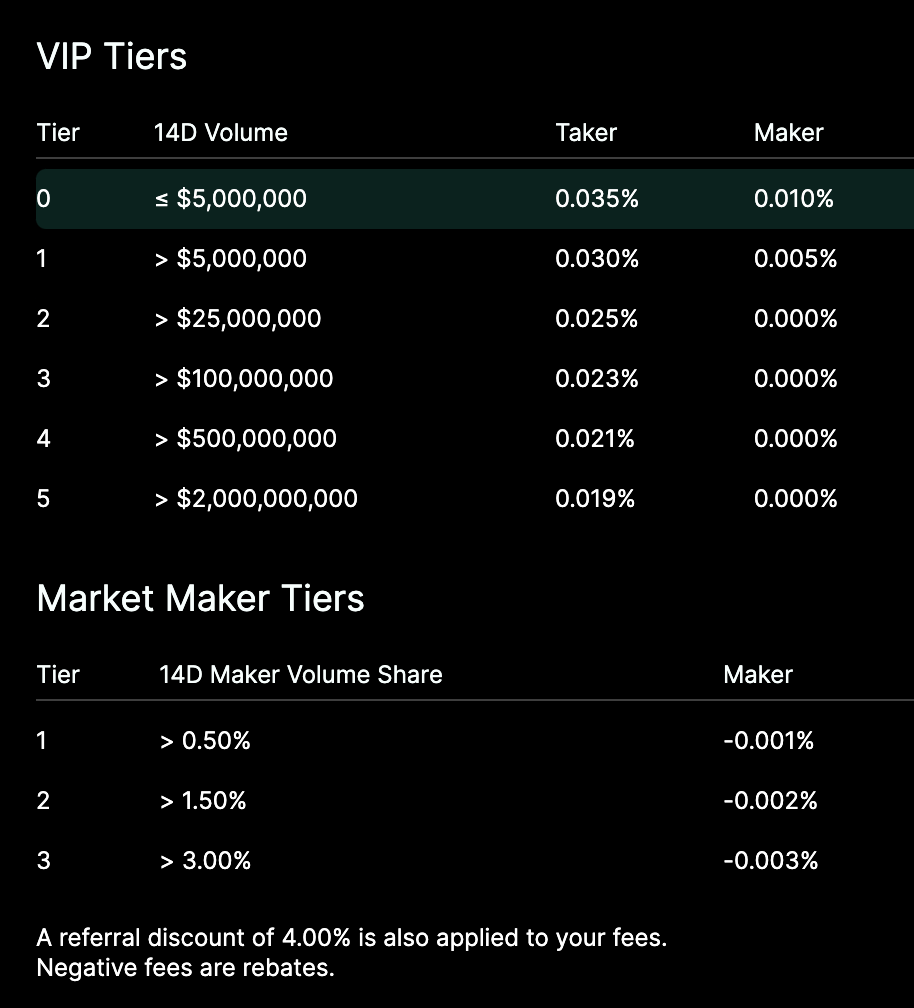
Hyperliquid’s fee structure
In addition to trading products, Hyperliquid has provided the Vault function from the beginning of the product creation. Vault is similar to the "following orders" in centralized exchanges. Everyone can invest funds in any Vault, and the Vault manager will make the investment. , 10% of the proceeds will be allocated to the Vault manager. At the same time, in order to maintain the consistency of interests, the manager needs to ensure that he holds at least 5% of the Vault shares.
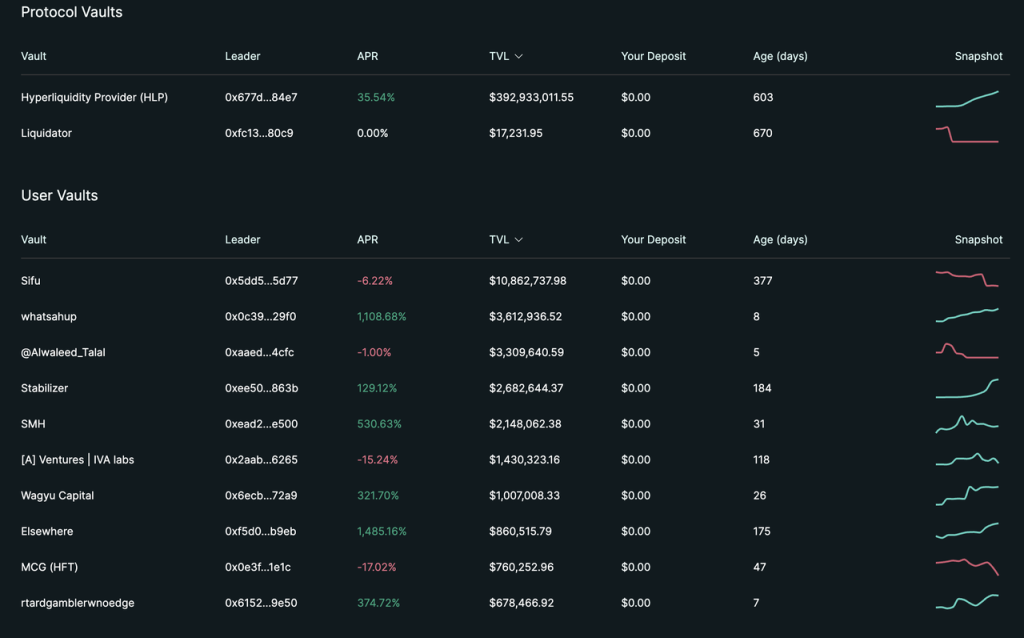
Source: hyperliquid official website
However, judging from the current TVL, 95% of TVL is in the official Vault HLP.
Different from the general Vault, because it is an official Vault, HLP actually acts as the counterparty for many transactions on the platform, so HLP can obtain part of the platform's various fees (transaction fees, capital fees, clearing fees) . From this perspective, HLP is relatively similar to GMX's GLP. The difference is that GLP acts as the counterparty to all transactions on the platform, and its strategy is passive and public; while HLP's strategy is non-public, and the counterparty to user transactions may be The HLP may also be other users, and the HLP's policy can also be adjusted at any time.
Since its launch in July 2023, HLP has almost always held a net short position to provide liquidity for retail transactions and maintain profits with a net short position in the long-term bull market. The current TVL is US$350 million and PNL is US$50 million. Judging from the overall PNL curve of HLP and the PNL of the three strategic addresses, the Hyperliquid team is using handling fees to maintain a relatively positive APR for its HLP.
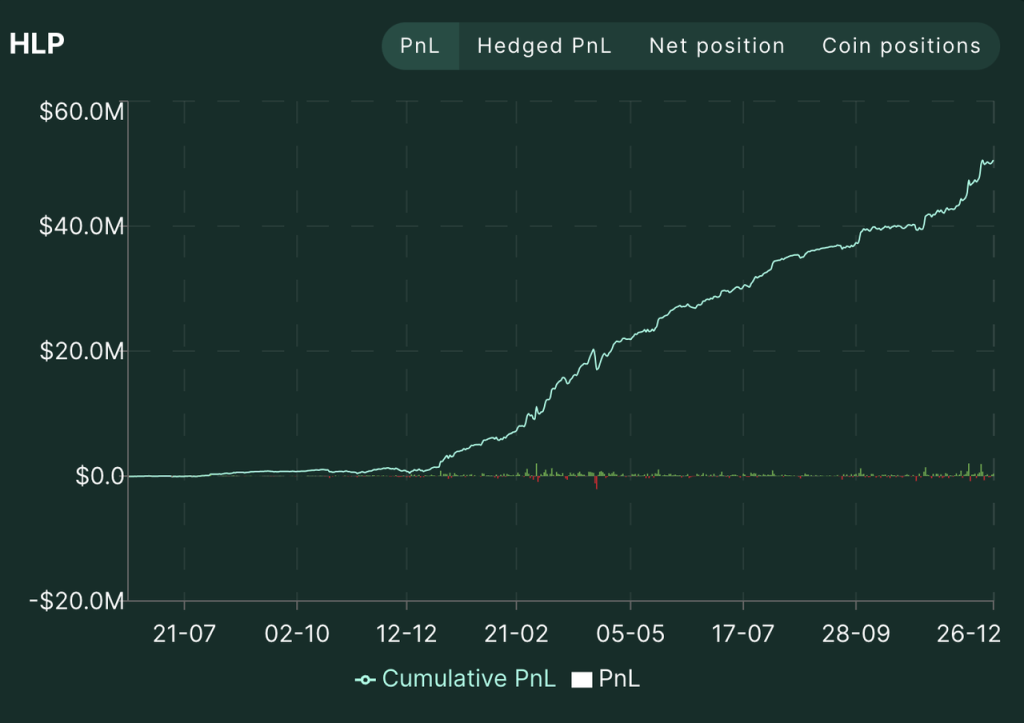
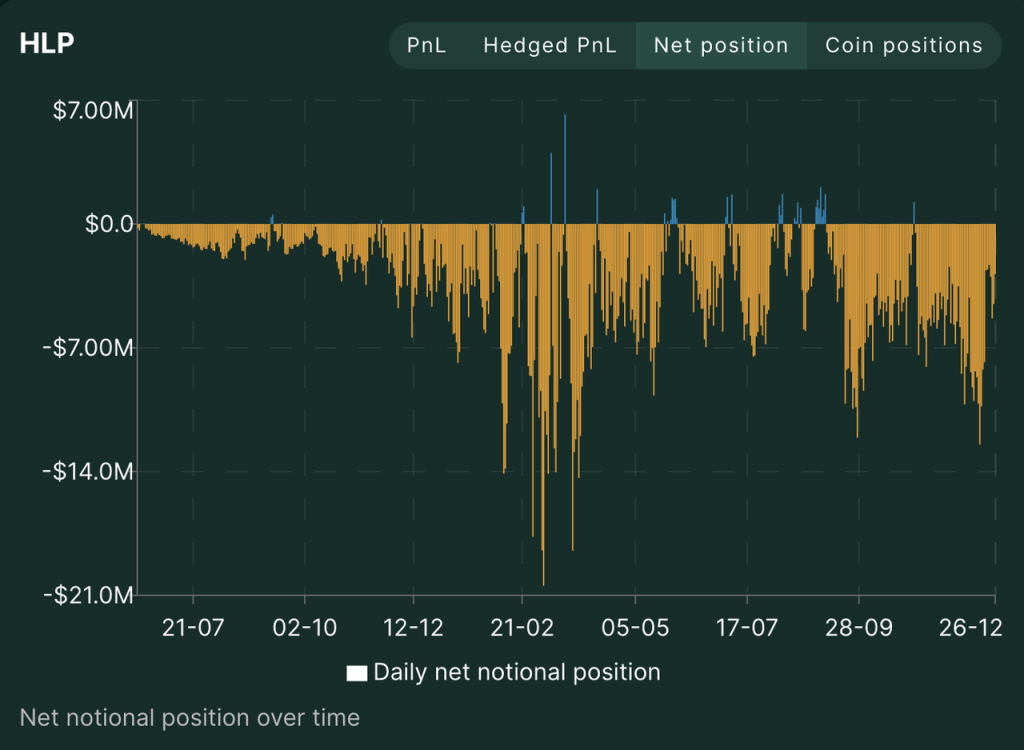
Source: Hyperliquid official website
Judging from trading volume and open interest, Hyperliquid has grown rapidly, especially in the past two months. As the $HYPE airdrop and price continued to rise, various data on the platform also reached highs between December 17-20.
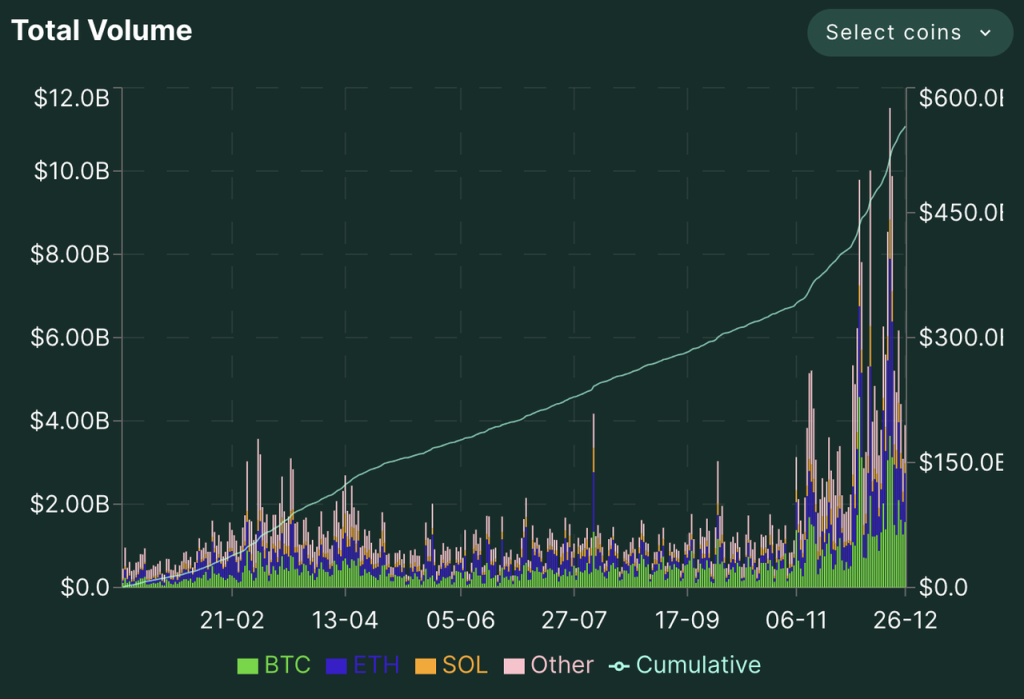
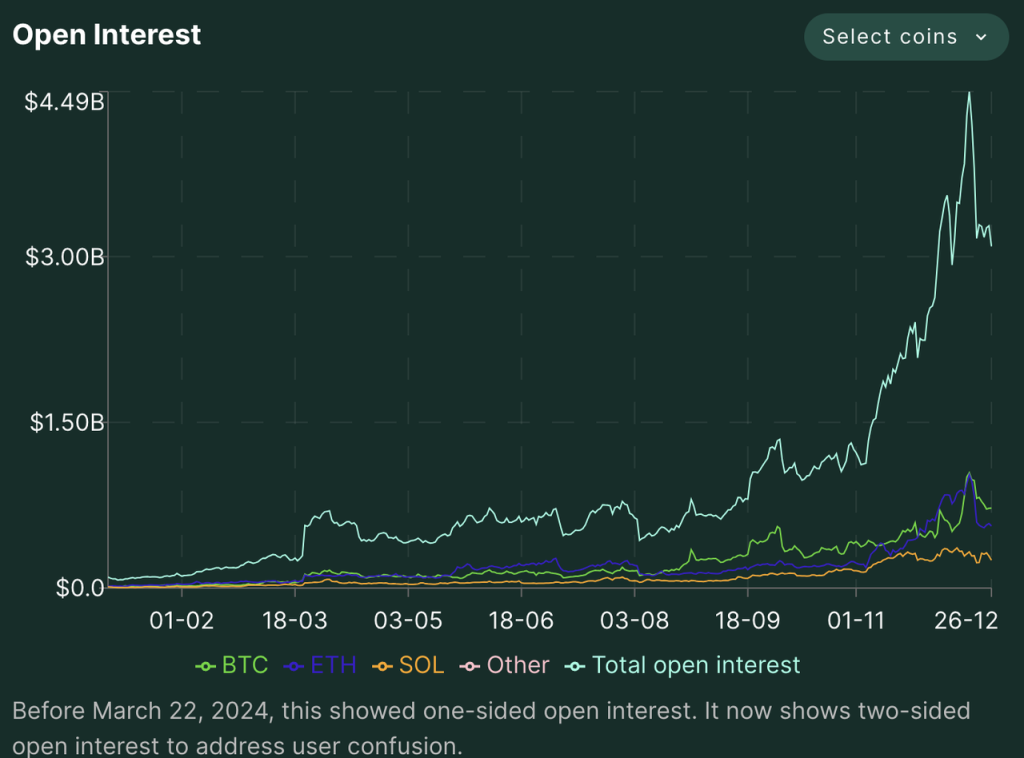
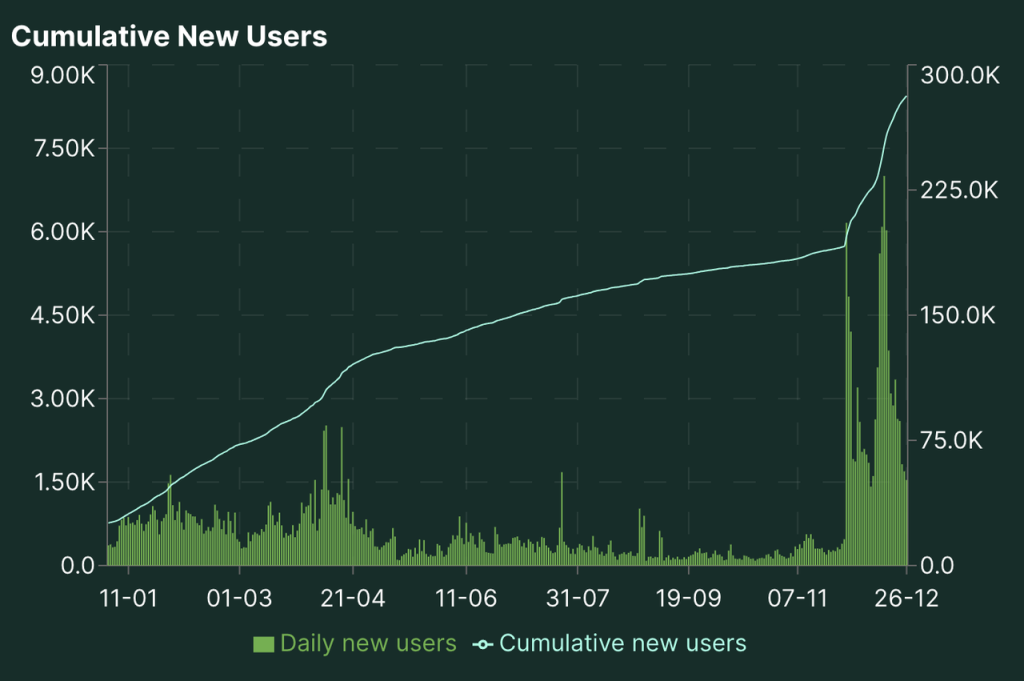
Source of Hyperliuqid’s trading volume, positions, and number of traders since 2024: Hyperliquid official website
In the field of decentralized derivatives market, in terms of trading volume, Hyperliquid has occupied a leading position since June this year. In the past two months, the gap between other decentralized derivatives exchanges and Hyperliquid has further widened. Currently, there are order of magnitude difference.
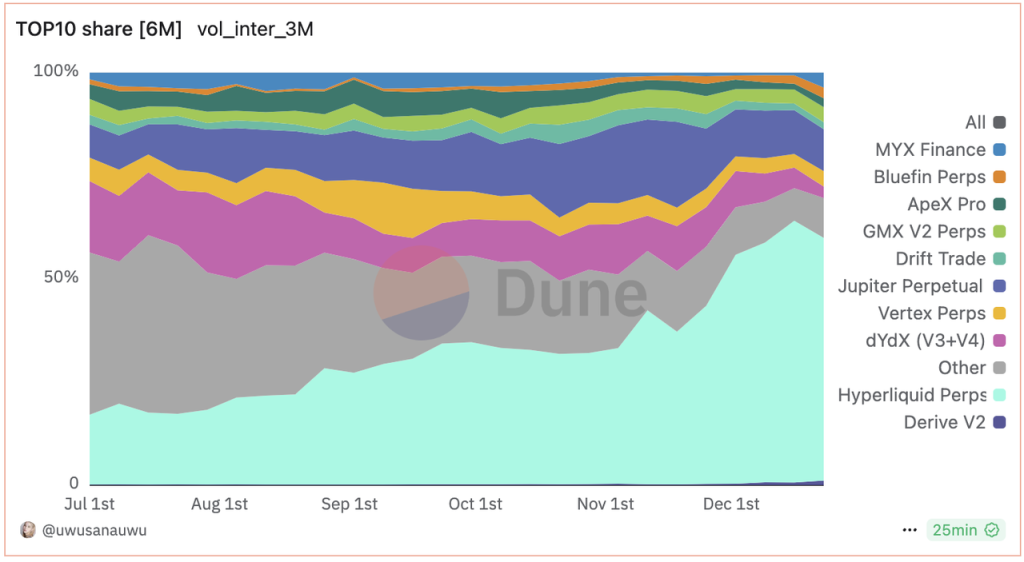
Source of trading volume of decentralized derivatives exchanges: Dune
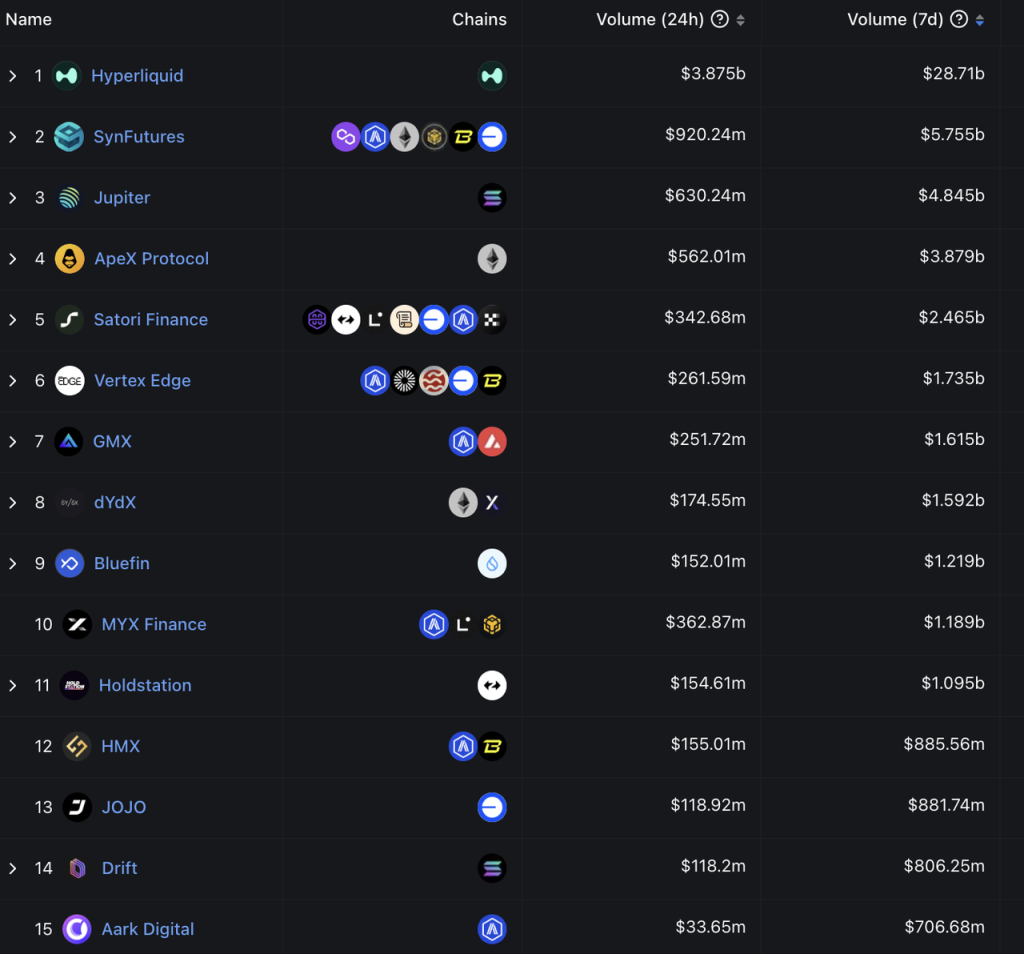
Decentralized derivatives exchange 7-day trading volume ranking source: DeFiLlama
From the perspective of valuation and trading volume, the more suitable comparable object for Hyperliquid is the centralized exchange.
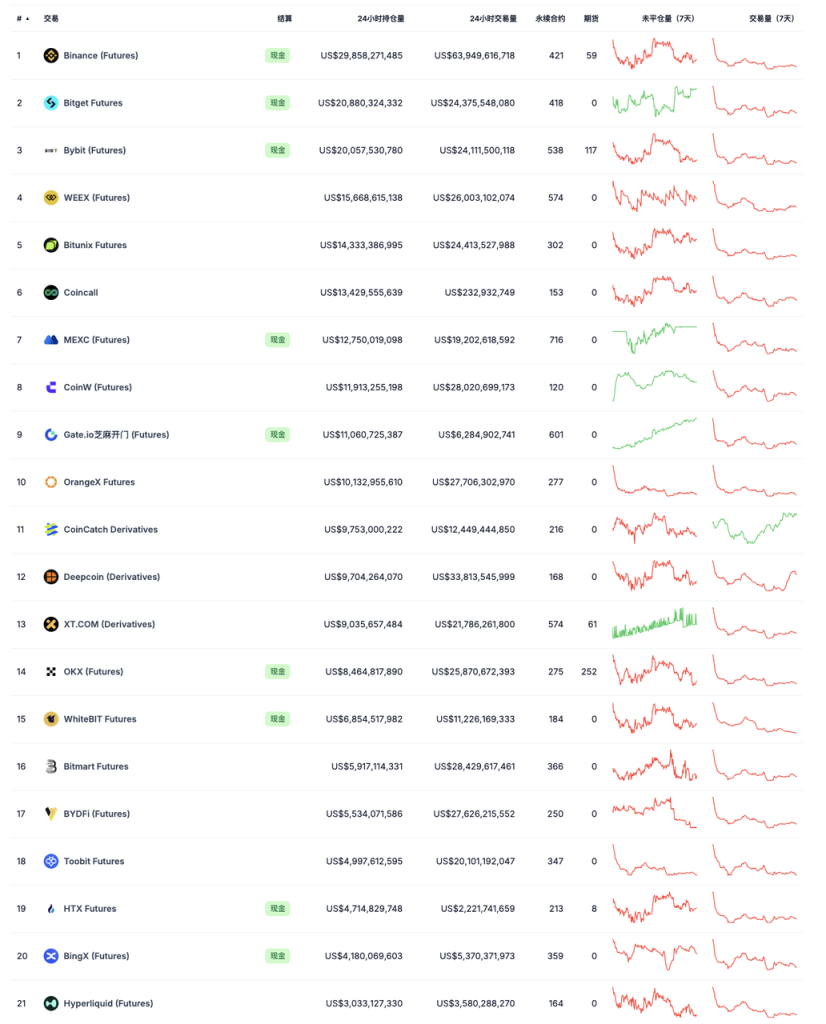
Screenshot time: 2024-12-28 Source: Coingecko
Hyperliquid's recent data has dropped significantly (the highest single-day trading volume is 10.4 billion US dollars, and the trading volume in recent days is less than 5 billion US dollars), but its holdings are still 10% of Binance's, and its trading volume is 6% of Binance's; positions and transactions The volume is roughly equivalent to 15% of Bitget and Bybit. At its peak of popularity (December 17-20), Hyperliquid's holdings could reach 12% of Binance's, and its trading volume reached 9% of Binance's; both its holdings and trading volume data were close to 20% of Bybit and Bitget's.
Overall, Hyperliquid's derivatives exchange has developed rapidly and has a relatively solid lead in the field of decentralized derivatives exchanges. Compared with leading centralized exchanges, the gap has been narrowed to less than 10 times. .
2.2 Spot exchange
Hyperliquid's spot exchange is also in the form of an order book, and is consistent with derivatives exchanges in terms of product structure and fee standards.
Currently, Hyperliquid's spot exchange only lists Hyperliquid's native assets that comply with HIP-1 standards, and does not list tokens from other chains.
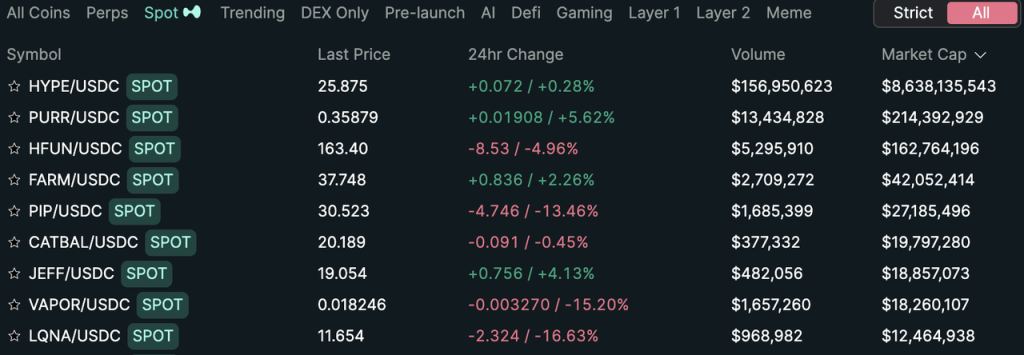
Hyperliquid’s current top spot tokens by market capitalization
HIP-1 (decentralized currency listing)
HIP-1 is similar to ERC-20 or SPL-20 and is the token standard of the Hyperliquid network. However, unlike ERC-20 and SPL-20, the cost of creating a HIP-1 token is quite high, because the successful creation of a HIP-1 token also means that it can be listed on Hyperliquid's spot exchange. .
Hyperliquid's HIP-1 was publicly conducted in the form of a Dutch auction, specifically:
Everyone can participate in the auction. The initial price of the auction is 2 times the last auction transaction price, and continues to decrease linearly to 10000U within 31 hours (this value is adjustable, it was previously lower, and was recently adjusted to 10000U). The first Developers who successfully bid will be eligible to create a TICKER. This TICKER can be listed on Hyperliquid's spot exchange, and the bidding amount will be paid in USDC.
Recent bidding and transaction prices:
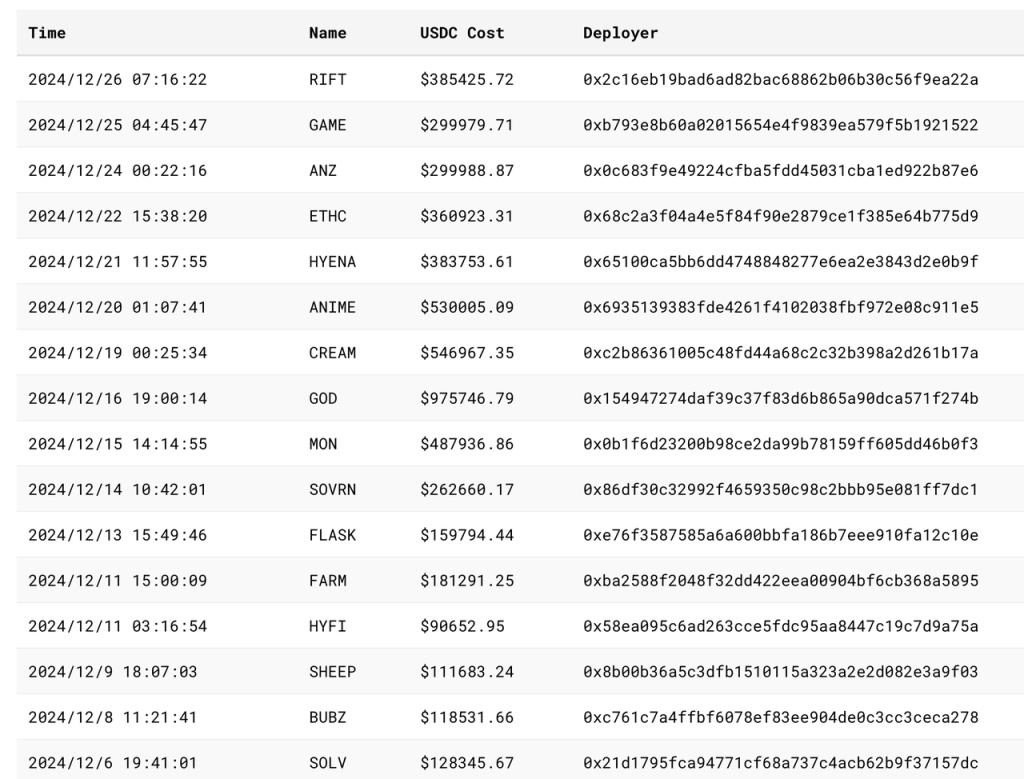
Source: asxn
Among them, the created Tickers worth noting include (in descending order by auction amount):
- GOD: Games invested by Pantera
- CREAM: Cream, a long-established lending project troubled by hackers, Machibigbrother related projects
- ANIME: It is Azuki’s token ticker. It is rumored that it was taken by the AZUKI team, but it has not yet been officially confirmed.
- MON: Publisher of the game Pixelmoon
- SWELL: The staking & re-staking protocol of the Ethereum ecosystem
- RIFT: Virtual-based game protocol J3ff
- GAME: It is rumored that it was shot by Virtual-based GAME, but it has not been officially confirmed yet.
- ANZ: Stablecoin protocol for base chain
- SOVRN: the former BreederDAO (the game asset platform invested by a16z and Delphi in the last cycle), will soon release the game on Hyperliquid
- FARM: Hyperliquid’s native AI pet game, launched through the Hyperfun platform
- ETHC: Machibigbrother related mining project
- SOLV: Bitcoin ecological pledge agreement, invested by BN labs, and has not yet issued coins.
SOLV can be roughly regarded as a dividing point for the HIP-1 auction. Previously, it was mostly based on meme and domain name logic. The tickers mostly had symbolic meanings, and the focus of the hype was on uniqueness within the ecosystem.
After SOLV, most projects came to seize the ecological niche and qualifications for currency listing, and the price gradually increased. The highest GOD sold for nearly 1 million US dollars. The project direction is mainly pan-entertainment, with games and NFT accounting for the majority, but there are also DeFi projects such as Solv, Swell and Cream.
In addition, it can be seen that as an exchange, Hyperliquid's spot "listing fee" has been stable at more than 100,000 US dollars in the past month, which is relatively close to the current listing fees of some second-tier centralized exchanges.
Through HIP1, Hyperliquid has a public "decentralized currency listing" mechanism. The currency listing fees paid are determined by market participants and will not encounter the problem of currency listing on centralized exchanges. On the other hand, the currency listing fees collected The fee will be used for HYPE repurchase and destruction, which is also beneficial to HYPE's price performance and valuation indicators.
HIP-2 (Hyperliquid’s AMM)
Since Hyperliquid's spot trading operates in the form of an order book, it is difficult to guarantee liquidity for new coins. Hyperliquid proposed HIP-2 to solve the initial liquidity problem of tokens created through HIP1.
Simply put, HIP2 provides an automatic market-making system that allows developers to automatically market the tokens generated through HIP-1. The market-making logic is linear market-making within an interval. The developer specifies the upper and lower price limits of the market-making interval. and buying and selling cut-off points. The system automatically divides every 0.3% price change into a grid and automatically makes market within the range.
The picture below is an order book using HIP-2 and its parameter settings:
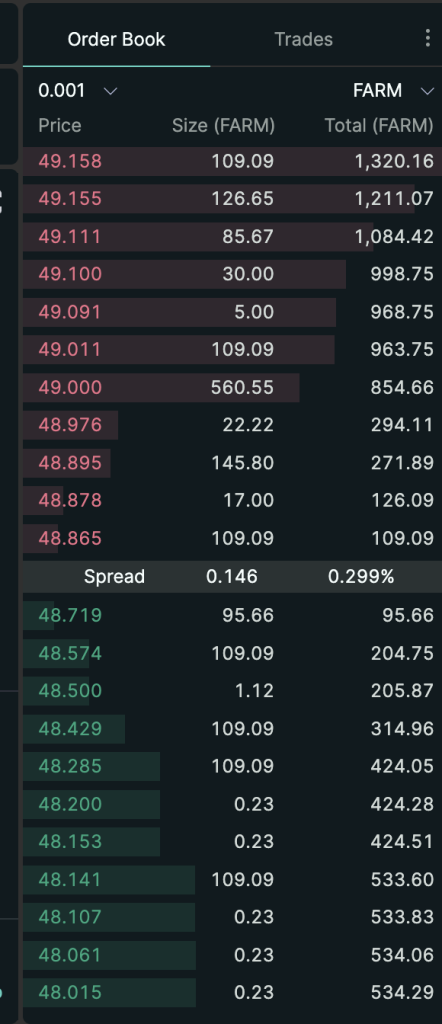

After the launch of HIP-2, many newly created Hyperliquid ecological tokens chose to use this Hyperliquid AMM mechanism. At present, the total USDC amount of HIP-2 has exceeded 25 million US dollars.
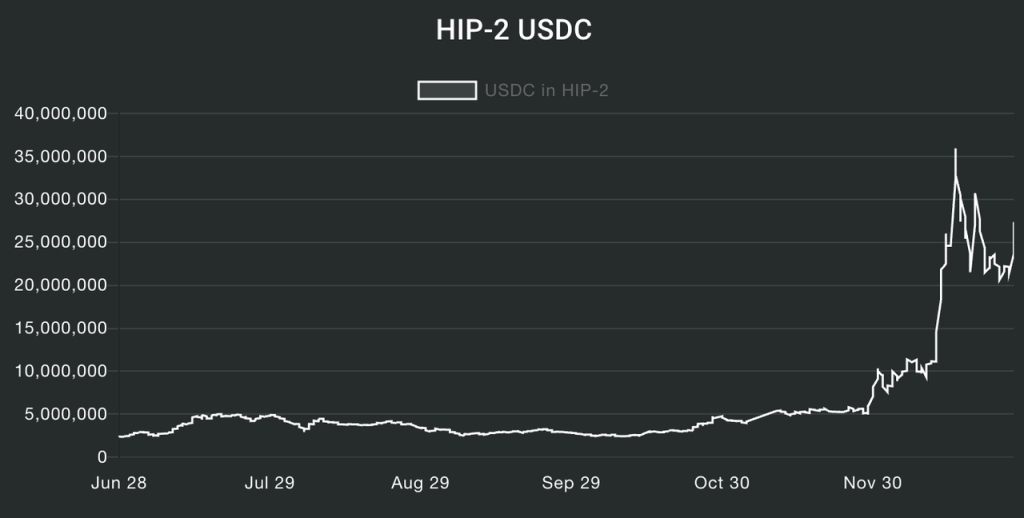
Hyperliquid's average daily spot trading volume in the past 30 days is about US$400 million, ranking among the top ten DEXs, and its trading volume is similar to Curve, Lifinity and Orca.
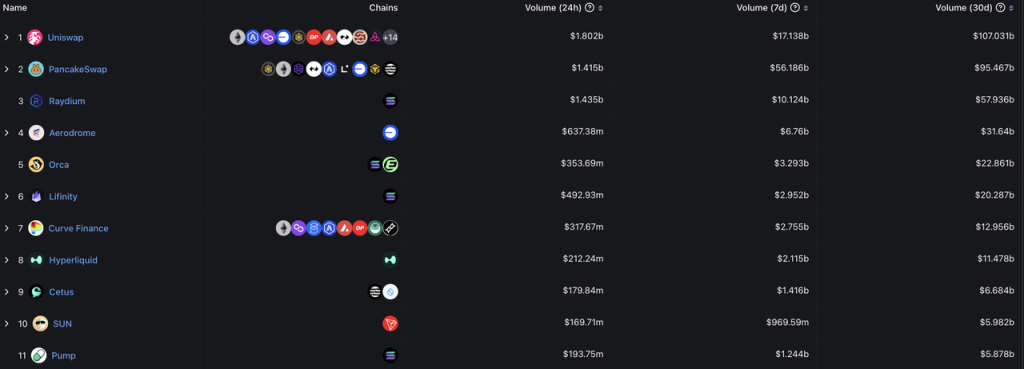
Source: DeFillama
2.3 HyperEVM
HyperEVM is not yet online. In Hyperliquid's official documentation, the RustVM currently running on derivatives and spot exchanges is called Hyperliquid L1, and HyperEVM is called EVM. According to the definition in its official documentation, HyperEVM is not an independent chain:
Hyperliquid L1 has a universal EVM as part of the blockchain state. Importantly, HyperEVM is not an independent chain, but is secured by the same HyperBFT consensus mechanism as other parts of L1. This enables the EVM to interact directly with native components of L1, such as spot and perpetual order books.
The ASXN report describes Hyperliquid's architecture with the following diagram:
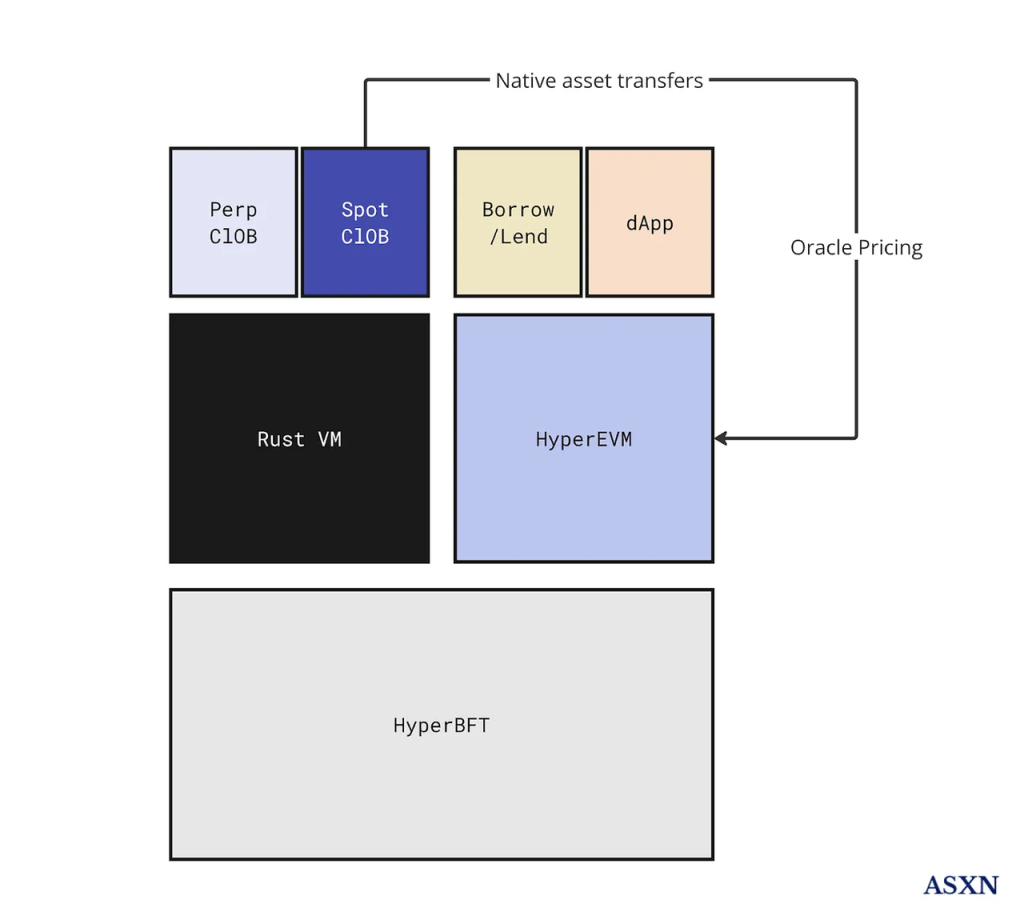
Hyperliquid is equipped with two sets of execution layers (RustVM and HyperEVM) on a consensus layer (HyperBFT). Its core functions of contract and spot are installed on RustVM, and RustVM will also focus on these two core dAPPs, and the remaining dAPPs are installed on On top of HyperEVM.
As for HyperEVM, according to the team’s documentation we know:
- Unlike RustVM, where Hyperliquid's current spot and exchange are located, HyperEVM is permission-free, which means that any developer can develop applications and issue assets (FT or NFT) on it.
- HyperEVM is interoperable with Hyperliquid's L1. For example, L1 oracles can be used by HyperEVM, and transfers of some currencies can also be interoperated between the two VMs. (It is not possible to all interoperate because the assets on L1 are "permitted" and only include USDC and assets generated through HIP-1, while HyperEVM has many more assets)
- HyperEVM will use Hyperliquid's native token $HYPE as Gas, and Hyperliquid's current L1 does not require users to pay Gas.
The author has not seen a similar product architecture in the crypto world before, and we are still unclear about the typical case of DeFi composability on the Ethereum network under the current architecture. "Deposit ETH into Lido to get stETH, and then put stETH into it." Deposit Aave, lend USDC, and then use USDC to buy Meme token PEPE" on HyperEVM and Hyperliquid L1 How to implement it (this may be the standard to define whether it is one chain or two chains), but in the author's current understanding, the relationship between HyperEVM and Hyperliquid L1 may be more similar to "L2 and L1 with certain interoperability" Relationship, or the relationship between a centralized exchange and its exchange EVM chain (such as the relationship between Binance and BNB Chain or Coinbase and Base Chain)
At present, the HyperEVM test network is in normal operation, and many validators have begun to participate in the HyperEVM test network verification. The more famous ones include Chorus One, Figment, B Harvest, Nansen, etc.
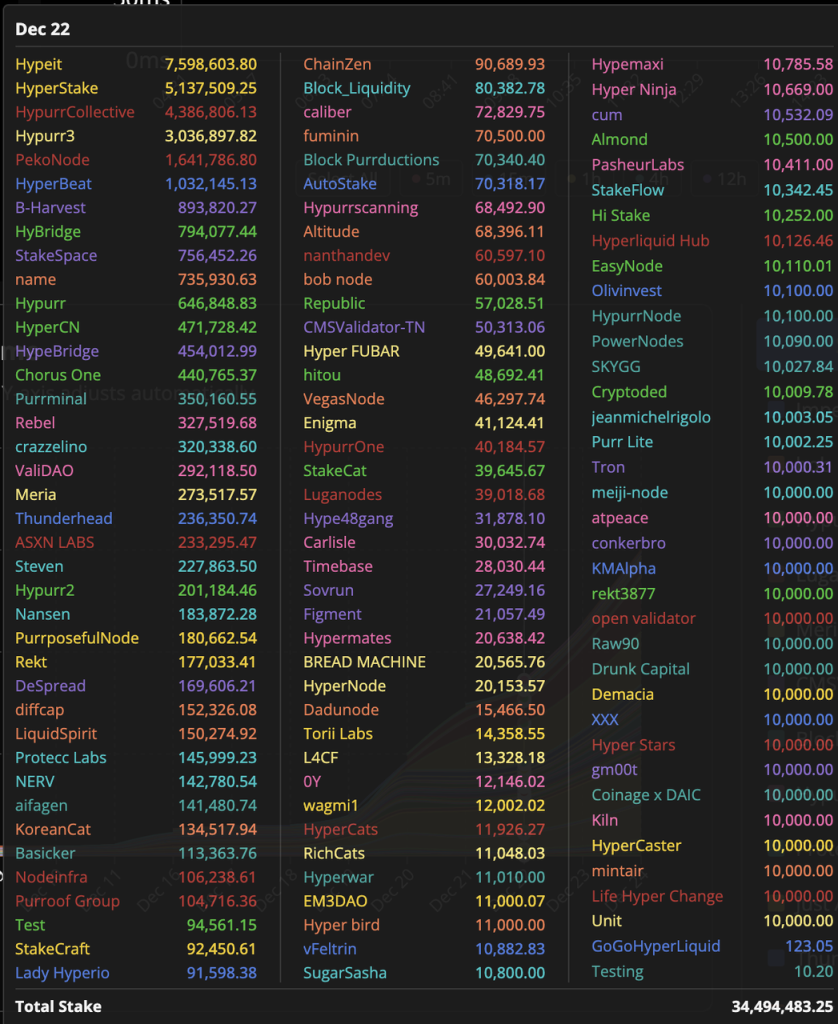
HyperEVM testnet verification node list source: ASXN
Since RustVM is not open to all developers, there are currently few applications developed for RustVM based on Hyperliquid, and most of them are transaction auxiliary tools:
Such as Telegram trading robot Hyperfun (token HFUN), Telegram social trading robot pvp.trade, trading terminals teastreet and Insilico, and derivatives trading aggregator Ragetrade, etc.
HyperEVM is open to all developers, and there are many projects planned to be released on HyperEVM. In addition to the projects we mentioned above that have successfully obtained HIP-1 tokens, the picture below and the Hypurr.co website both list quite a few part.
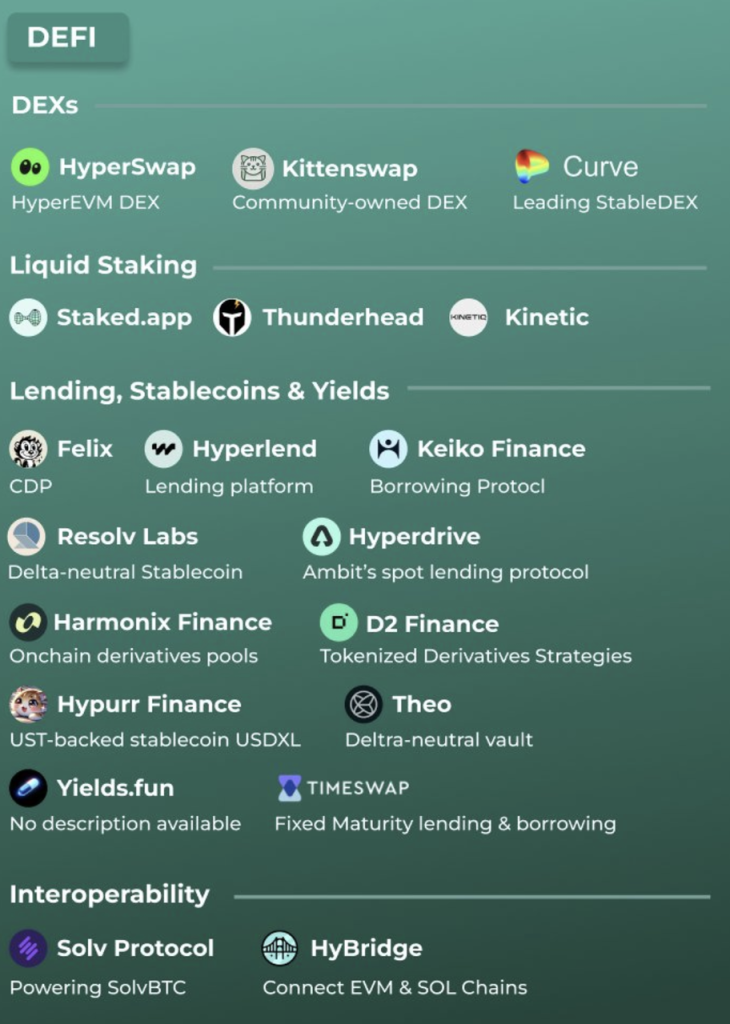
We still have to wait for its official launch to find out the specific mechanism of HyperEVM and its relationship with Hyperliquid L1. At present, the official has not given a planned launch time for HyperEVM.
Summary: Hyperliquid’s current overall business positioning is similar to that of leading trading groups. Its core business is trading + L1 operations, and it has become a direct competitor of major trading groups. Although the business model is consistent, compared with existing leading trading groups, Hyperliquid is different in that it chooses to build its trading business on the chain. Compared with CEX, which requires permission and has opaque data, the advantage of Hyperliquid's trading platform is that it is permissionless. Access (without KYC), transparent and verifiable business data, better composability, and lower comprehensive operating costs also give it the ability to channel more revenue and profits to its token HYPE.
3. Hyperliquid team, token economic model and valuation
3.1 Team
Hyperliquid has two co-founders, Jeff Yan and iliensinc, who are alumni of Harvard University. Before entering the encryption industry, Jeff worked at Google and Hudson River Exchange. The Hyperliquid team is quite streamlined. According to ASXN's September report, there are 10 team members, 5 of whom are engineers. This is especially true for a derivatives exchange with a daily trading volume of over 10 billion.
Judging from the entire product process currently built by the Hyperliquid team, especially their insistence on self-funded research and development, self-built high-performance chain to achieve a complete on-chain order book, and the highly innovative HIP-1, although the team has streamlined personnel, its The ability to always solve problems based on first principles is impressive.
3.2 $HYPE Economic Model
The total amount of $HYPE is 1 billion, which will be officially released on November 29, 2024. Since there is no financing, there is no investor share. The specific distribution is as follows:
- 31.0% of the genesis allocation was airdropped to Hyperliquid’s early users according to the number of points, and is fully circulated.
- 38.888% for future emissions and community rewards
- 23.8% is allocated to the team and will be released after 1 year of locking. Most of it will be released between 2027 and 2028, and some will continue to be released after 2028.
- 6.0% Hyper Foundation
- 0.3% community grants
- 0.012% HIP-2
The overall distribution between the team and the community is 3:7. The current currency holding addresses are as follows:
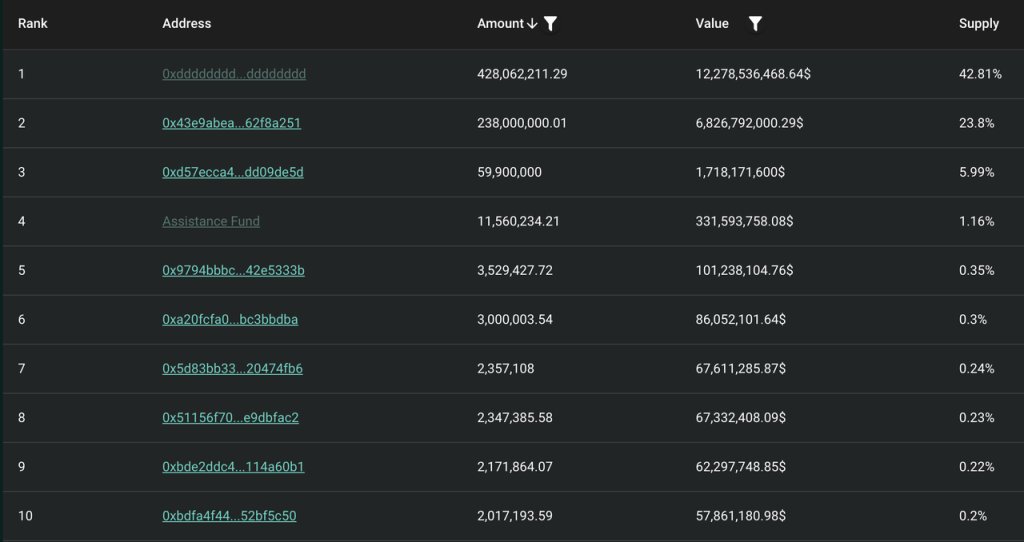
Excluding community addresses, team addresses and foundation addresses, the address currently holding the most coins is Assistance Fund (hereinafter replaced by AF), which holds 1.16% of the total HYPE supply and 3.74% of the circulating supply.
Currently, there are two parts that involve fees in the entire Hyperliquid ecosystem: transaction fees and HIP-1 auction fees. Transaction costs include spot and contract transaction fees, contract funding fees, and contract clearing fees. Since Hyperliquid L1 does not charge gas fees to users, and HyperEVM has not yet been launched, Hyperliquid's current revenue does not include transaction gas fees.
According to the team in the documentation:
On most other protocols, the team or insiders are the main beneficiaries of fees.On Hyperliquid, fees are entirely directed to the community (HLP and the assistance fund). For security, the assistance fund holds a majority of its assets in HYPE, which is the most liquid native asset on the Hyperliquid L1.
In most other agreements, the team or insiders are the primary beneficiaries of the fees. At Hyperliquid, fees belong entirely to the community (HLP and aid funds). The Assistance Fund holds the majority of its assets in HYPE as this is the most liquid native asset on Hyperliquid L.
All fees are fully attributed to HLP and AF. However, the team did not clearly inform the ratio of fees between HLP and AF.
Fortunately, the data of Hyperliquid L1 is publicly available. According to the speculation logic of @stevenyuntcap, as of early December, Hyperliquid has subsidized HLP by a total of US$44 million since its launch, and the initial AF funds used to purchase HYPE were US$5,200. Ten thousand US dollars, it can be concluded that Hyperliquid’s cumulative revenue from its launch to the beginning of December is US$96 million, that is, the total revenue of the agreement is between HLP and AF The distribution ratio is 46%:54%. (In addition, we can also use Hyperliquid's cumulative transaction volume of US$428 billion during this period to calculate the average contract rate of the Hyperliquid protocol to be about 0.0225%).
Since all of AF's USDC currently repurchases HPYE, we can simplify it as follows: 46% of Hyperliquid's perpetual contract trading revenue during this period was allocated to the supply side (HLP holders), and 54% was used to repurchase $HYPE tokens. currency.
Of course, in addition to the perpetual contract transaction fees, Hyperliquid will also have two parts of income that will benefit HYPE holders: the auction fees from HIP-1 and the USDC part of the spot transaction fees. Currently, these two parts of income are also all Enter AF to repurchase HYPE (it also includes the HYPE part of the HYPE-USDC spot transaction fee, which is currently directly destroyed, with a total of 110,000 HYPE destroyed).
At present, AF's strategy is still to regularly purchase all accumulated USDC as HYPE, so we can simply track Hyperliquid's profits and the repurchase intensity of HYPE based on AF USDC inflow data. According to data from hyperdata.info, AF's cumulative USDC inflow currently exceeds US$77 million, with more than US$25 million in the past month, and the average daily repurchase of HYPE is approximately US$1 million.

On December 30, 2024, Hyperliquid officially launched the HYPE staking function. The current return rate of HYPE staking is about 2.5%. This part of the income only includes fixed PoS consensus layer income, and its rate of return consensus refers to the Ethereum consensus layer. Consensus on the rate of return (the rate of return is inversely proportional to the square of the number of pledged HYPE). Currently, in addition to the 300 million tokens of the team and foundation, there are also close to 3,000 Thousands of user tokens participated in the pledge.
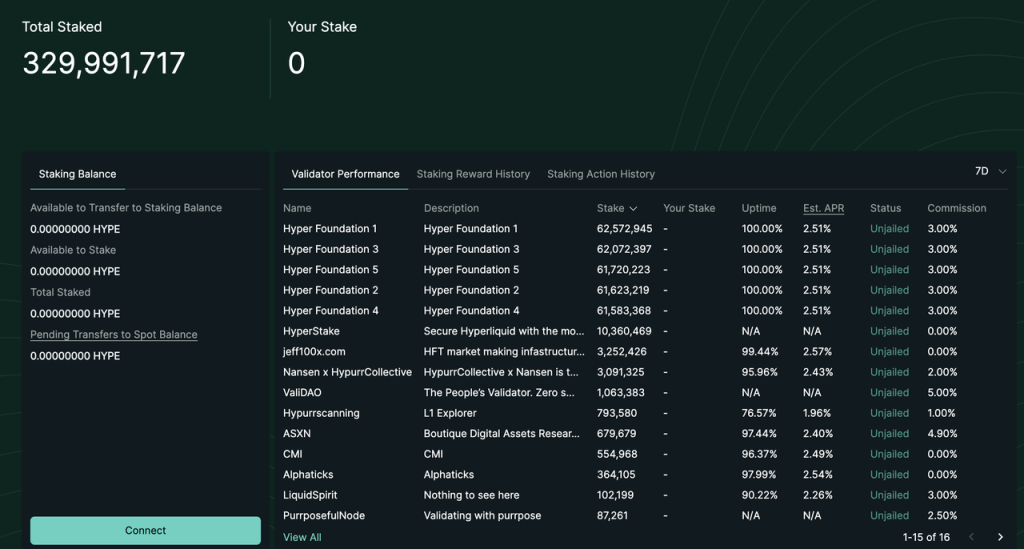
Looking to the future, there are still many possible adjustments to HYPE’s economic model in the future, such as:
-
HyperEVM is online,
-
$HYPE is used as gas for HyperEVM
-
The income from the execution layer is distributed to HYPE pledgers (the current HYPE pledge income only includes)
-
Fees are redistributed to $HYPE holders
-
$HYPE staking fee discount
3.3 Valuation
Below we will discuss the following 2 valuation frameworks for Hyperliquid. Before we begin, we need to point out the following:
- Hyperliquid's own data has changed greatly - its market capitalization, TVL, revenue, user data, etc., have increased several times or even dozens of times based on the original value in the past month, and then experienced a 50% retracement. The intensity of changes in the own indicators is far greater than the comparison shown by the valuation indicators we list below. The following valuation framework is more suitable as a long-term valuation reference.
- HYPE price is currently Hyperliquid's biggest fundamental. The surge in its various data is more a result of the increase in HYPE price than "because Hyperliquid has such good data, it has such a price."
Framework 1: Comparing BNB
The main thesis of Hyperliquid is the "on-chain binance" proposed by messari:
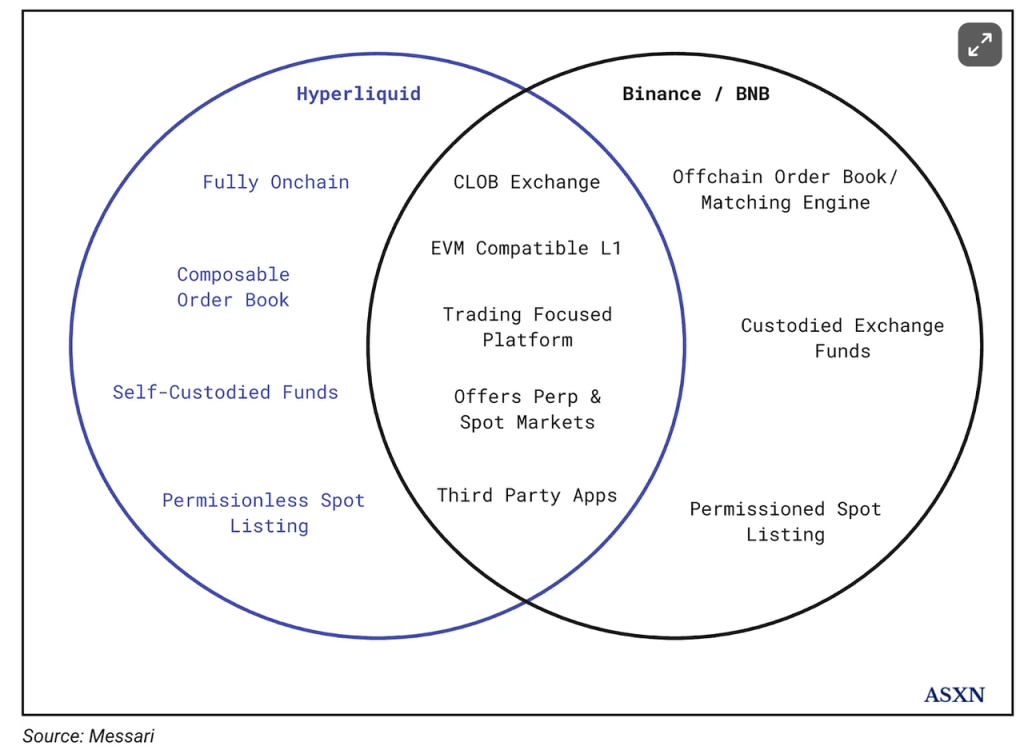
This analogy is generally reasonable and may indeed be a better framework. Binance/BNB may indeed be the most suitable comparison object for Hyperliquid/HYPE.
- Hyperliquid’s core business is derivatives and spot exchanges, which is consistent with Binance’s corresponding main business;
- HyperEVM can be compared with BNBChain. Although HyperEVM has not yet been launched, according to the current design, both HYPE and BNB can be used as Gas for the EVM chain, and both can be pledged to obtain income;
- Both HYPE and BNB can directly benefit from platform transaction fees;
Below, we will divide it into derivatives exchanges, spot exchanges, and EVM according to the Hyperliquid architecture to compare with Binance.
- Derivatives Exchange:
We mentioned above that recent data such as Hyperliquid's positions and trading volume are around 10% of Binance's corresponding data, so we roughly believe that in the derivatives exchange module, HYPE = 10% BNB.
- Spot exchange:
Hyperliquid's average daily spot trading volume in the past thirty days is around US$400 million, while Binance's average daily spot trading volume, excluding the fee-free FDUSD trading pair, is around US$26 billion, with HYPE = 1.5% BNB.
- EVM:
According to the logic above, we believe that the relationship between HyperEVM and Hyperliquid L1 is more similar to the relationship between Binance exchange and BNBChain.
HyperEVM is not yet online. We cannot confirm how many TVLs will be migrated from RustVM to HyperEVM. However, from the perspective of product architecture and corresponding experience, the overall logic is still based on the migration of existing users of the exchange. We list the data of Binance and Coinbase. Taking into account the relatively hot market sentiment towards Hype, we assume that 10% of Exchange TVL will be migrated to the chain (still optimistic, but currently most use TVL The valuation articles all assume that 100% of Hyperliquid TVL will be migrated to HyperEVM). According to this calculation, HYPE = 3%BNB.
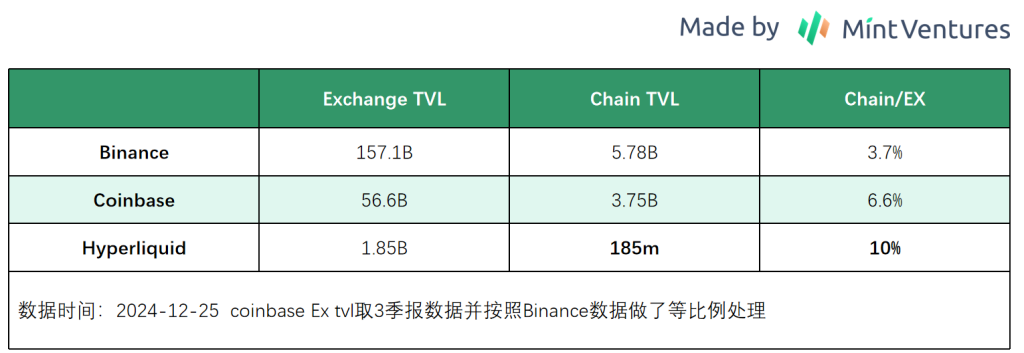
- economic model
In addition, we also need to consider the differences between the HYPE and BNB economic models.
From the above analysis of the HYPE economic model, we can see that HYPE currently converts 54% of the platform's gross profit and 100% of the net profit into the repurchase or destruction of HYPE.
BNB has previously used 20% of the Binance exchange's net profit to repurchase BNB in accordance with the white paper. After the repurchase and destruction is decoupled from the platform's net profit in 2021, we have no way of knowing the proportion of Binance's net profit empowerment of BNB. However, from Judging from the changing trend of the destruction data and Binance's market position at the same time, the proportion of net profit destruction is probably maintained at a similar level.
From the perspective of the economic model (for currency holders), HYPE is significantly better than BNB.
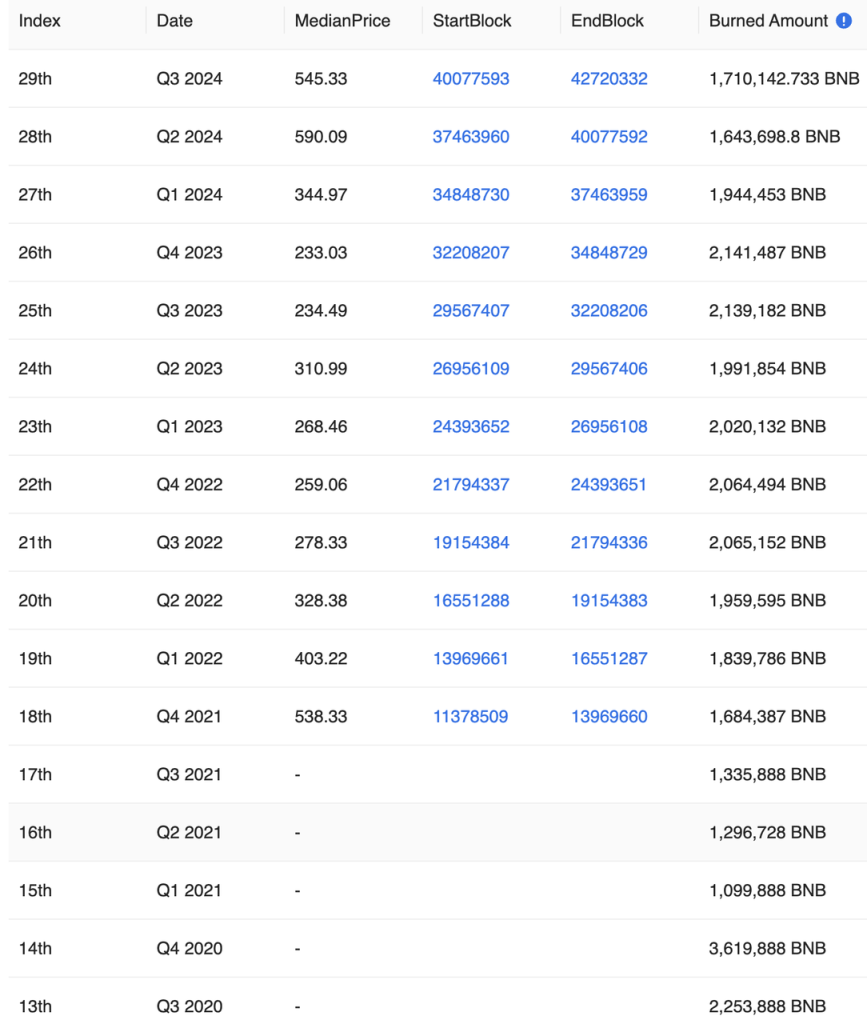
BNB historical destruction data source
It is also worth mentioning that the current proportion of Hyperliquid’s revenue flowing to HYPE tokens is 54%, and this value still has room for further growth. Due to mechanism reasons, HLP has been holding a large number of cryptocurrency short positions using USDC as collateral in the bull market since July 2023 when BTC has increased by more than 200%. Although HLP's own strategy is appropriate and it is rare to maintain a breakeven, However, you still need to pay an annual APR of more than 30% to retain funds in the HLP.
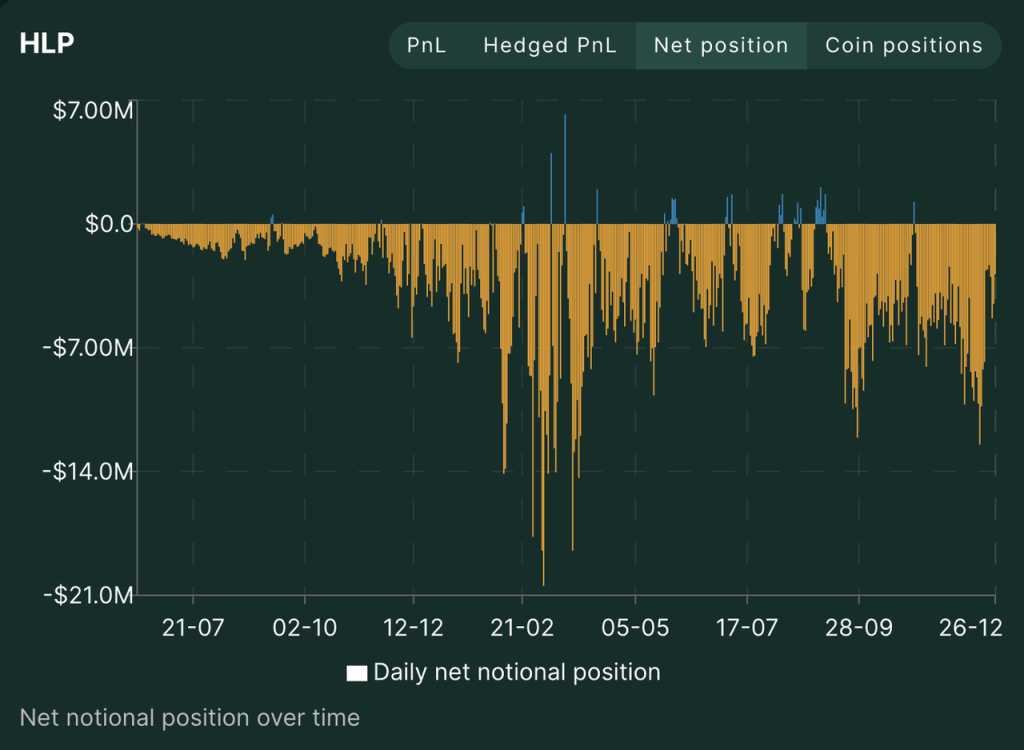
HLP historical net position source: Hyperliquid official website
In the future, as the market gradually peaks, the overall trend of crypto users being net long in derivatives will not change. The probability of HLP’s own strategic returns increasing in volatile and bear markets increases (from GMX’s GLP and GNS’s Vault). We can see the same trend in historical earnings), Hyperliquid may not need to pay such a large proportion of its income as rent to HLP, and Hyperliquid's net profit margin is still expected to further improve.
When it comes to net interest rates, we have no way of knowing what Binance’s net interest rates are, but we can get a glimpse of the operating costs of centralized exchanges from the report of listed company Coinbase.
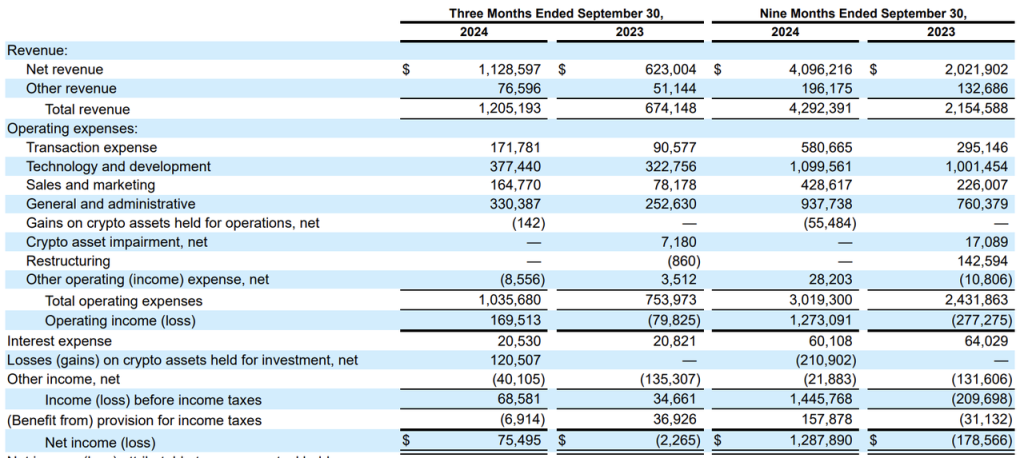
Coinbase quarterly report 24Q3
It can be seen that Coinbase's operating expenses (R&D, management, sales expenses and transfer expenses) will average more than 600 million US dollars per quarter in 2023, which is basically equivalent to all revenue, and the net interest rate is close to 0; in 2024, with the market After the outbreak, its net interest rate has improved a lot, but the net interest rate is still less than 30%.
From the above numerical comparison, we can clearly see the advantages of Hyperliquid's net interest rate (economic model) compared to centralized transactions. We can also look at this advantage in detail from a specific event: the handling of currency listing issues.
Centralized exchanges usually have a dedicated listing team responsible for listing coins. They need to track market hot spots and negotiate with various project teams to collect currency listing fees and/or project tokens. Centralized exchanges need to pay the currency listing team considerable wages and commissions, and also need to pay to monitor and process the currency listing process. There may be benefits transfer issues to the internal control team's salary.
As mentioned above, Hyperliquid's coin listing process HIP-1 runs automatically based on predetermined codes. The operating cost of new coin listings is infinitely close to 0, so that its income "listing fees" can be fully allocated to HYPE holders. people.
To sum up, now at the end of December 2024, we have the following comparison:
- Derivatives trading: HYPE = 10% BNB
- Spot trading: HYPE = 1.5% BNB
- EVM (estimated): HYPE = 3% BNB
- Economic model: HYPE is significantly better than BNB
- Circulation market capitalization: HYPE = 9% BNB
- Full circulation market capitalization: HYPE = 27% BNB
Derivatives trading is Hyperliquid's current main business and should have a relatively high weight in valuation comparisons. In the author's opinion, although HYPE's current market value is far from cheap, it is not expensive either.
Frame 2: PS
HYPE has token repurchase and destruction mechanisms, both of which directly affect HYPE tokens. PS indicators can be used for valuation, as follows:
- Contract transaction fees:
We base our estimates on an average contract transaction fee of 0.0225% and a profit split of 46:54 between HLP and AF.
Hyperliquid contract revenue in the last month = US$154.7 billion * 0.0225% = US$34.8 million, of which approximately 54% went into AF to repurchase HYPE. The amount of HYPE repurchase = US$18.79 million, corresponding to an annualized net profit of US$225.5 million.
- HIP-1 auction fee:
The revenue in the latest month was US$6.1 million. Based on the distribution ratio of HLP and AF 46:54, this part corresponds to an annualized net profit of US$39.5 million.
- Spot transaction fees:
The fee standard for Hyperliquid's spot transaction fees is the same as that of contract transactions. The USDC part of the fee is also distributed in the same way as contract transactions, that is, the profit is distributed 46:54 between HLP and AF; the procedures for other tokens in spot transactions are Fees (for example, in HYPE-USDC transactions, the HYPE buyer pays the USDC handling fee, and the HYPE seller pays the HYPE handling fee) is directly destroyed.
Therefore, we need to calculate the net profit of HYPE from spot transaction fees in two parts:
- HYPE part: You can query it directly through the block explorer. The HYPE token TGE lasts exactly 30 days. The number of HYPE destroyed is 110,490 pieces, corresponding to the annualized destruction of 1,325,880 pieces, which is approximately US$37 million at current prices.
- USDC part: Hyperliquid spot trading volume in the last 30 days was US$11.5 billion. The part used to repurchase HYPE in spot transactions = US$11.5 billion * 0.0225 * 54% = US$1.397 million, corresponding to an annualized net profit of US$16.77 million.
Combining the above three parts of expenses, we annualized the data based on the latest month and found that the amount used to repurchase HYPE was US$318,770,000.
Calculated based on the circulating market capitalization, HYPE's P/S is 29.4. Calculated based on the full circulating market capitalization, HYPE's P/S is 88.
We have listed the circulating P/S indicators of some crypto projects that are comparable to Hyperliquid:

It can be seen that the P/S valuation of L1 is significantly higher than that of the application, and the P/S valuation of Hyperliquid is significantly lower than that of other comparable L1s.
The above are two frameworks for the valuation of HYPE. What needs to be reminded again is:
Hyperliquid's own data has changed greatly - its market capitalization, TVL, revenue, user data, etc., have increased several times or even dozens of times based on the original value in the past month, and then experienced a 50% retracement. The intensity of changes in the own indicators is far greater than the comparison shown by the valuation indicators we list below. The above valuation framework is more suitable as a long-term valuation reference.
HYPE price is currently Hyperliquid's biggest fundamental. The surge in its various data is more the result of the increase in HYPE price, rather than "because Hyperliquid has such good data, it has such a price."
4. Risks
The risks faced by Hyperliquid are as follows:
- Funding risk. Currently, all Hyperliquid funds are stored in the bridge of its Arbitrum network. The security of the smart contract and the multi-signature security of the 3/4 team that manages all funds are crucial.
- Code risks, including current L1 risks and HyperEVM risks. Hyperliquid adopts an innovative architecture and consensus, and the current non-open source status of its L1 reduces the possibility of being attacked. However, as the scale and influence of Hyperliquid increases, and HyperEVM comes online, the possibility of potential attacks/code vulnerabilities gradually increases. increase.
- Oracle risk, which is an inherent risk in all derivatives exchanges.
- Regulation causes a loss of comparative advantages. The lack of KYC is currently Hyperliquid's main comparative advantage over centralized exchanges. As the scale of Hyperliquid continues to grow, there may be regulatory requirements such as anti-money laundering from regulation.
References:
https://hyperfnd.medium.com/hype-genesis-1830a4dc2e3f
https://newsletter.asxn.xyz/p/hyperliquid-the-hyperoptimized-ord
https://data.asxn.xyz/dashboard/hl-auctions
https://hypurrscan.io/token/0x0d01dc56dcaaca66ad901c959b4011ec
https://www.prestolabs.io/research/hyperliquid-the-hype-begins#4.1-Decentralization
https://x.com/0xak_/status/1871051318267445562
https://x.com/Darrenlautf/status/1869961681671184629


 jinse
jinse
